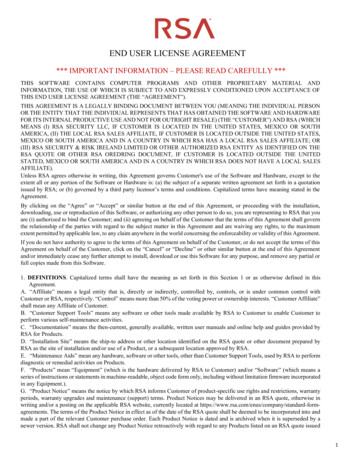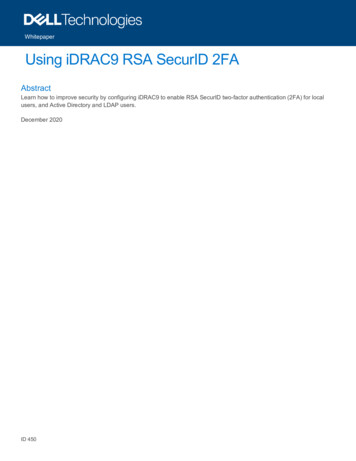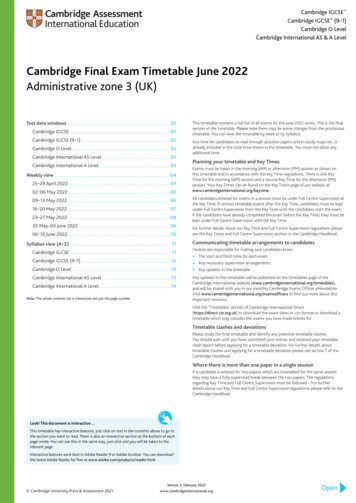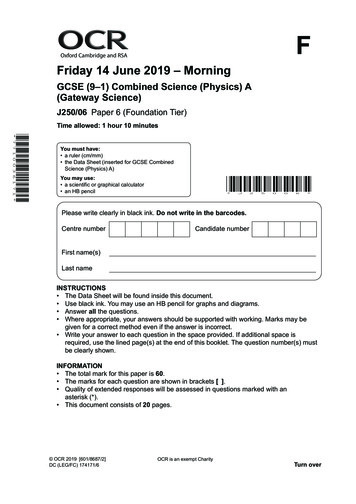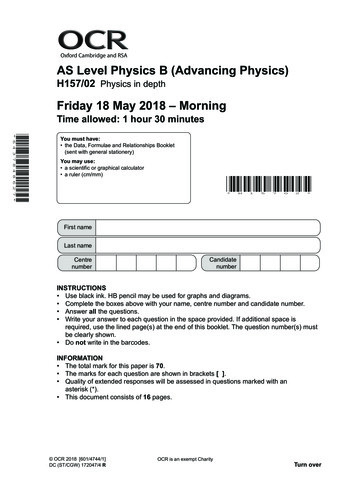
Transcription
Oxford Cambridge and RSAAS Level Physics B (Advancing Physics)H157/02 Physics in depthFriday 18 May 2018 – MorningTime allowed: 1 hour 30 minutes* 6 4 3 7 8 4 8 6 2 7 *You must have: the Data, Formulae and Relationships Booklet(sent with general stationery)You may use: a scientific or graphical calculator a ruler (cm/mm)*H15702*First nameLast nameCentrenumberCandidatenumberINSTRUCTIONS Use black ink. HB pencil may be used for graphs and diagrams. Complete the boxes above with your name, centre number and candidate number. Answer all the questions. Write your answer to each question in the space provided. If additional space isrequired, use the lined page(s) at the end of this booklet. The question number(s) mustbe clearly shown. Do not write in the barcodes.INFORMATION The total mark for this paper is 70. The marks for each question are shown in brackets [ ]. Quality of extended responses will be assessed in questions marked with anasterisk (*). This document consists of 16 pages. OCR 2018 [601/4744/1]DC (ST/CGW) 172047/4 ROCR is an exempt CharityTurn over
2SECTION AAnswer all the questions.1A book is held 25 cm from an eye. This is the smallest distance from an object for which a normaleye can form a clear image.Light is refracted by the cornea and the lens together, and a clear image is formed on the sensitiveretina, 2.1 cm behind the lens.The ray diagram for this arrangement is shown in Fig. 1.bookcornearetinalensFig. 1(a) Calculate the power P of the combination of the cornea and the lens.P . D [2](b) The sensitive cells at the centre of the retina are separated by 2.5 μm.Calculate the distance d on the book that would correspond to this separation in the image onthe retina.d . m [2](c) A long-sighted person cannot focus on an object 25 cm from the eye. Carol is long-sightedand the closest object that forms a sharp image on her retina is 1.5 m from the eye.Explain why Carol has difficulty reading small print in a book when she is not using herglasses. [2] OCR 2018
32A modern digital television has a screen measuring 1280 pixels by 720 pixels (Fig. 2).1280 pixels720 pixelsFig. 2(a) Each pixel is encoded by 3 bytes, one for each of the colours red, green and blue. A newimage is displayed on the screen 30 times each second.Calculate the number of gigabytes needed to encode a high-definition video lasting for onehour. You can assume that every pixel must be encoded every time a new image appears onthe screen.number . GB [2](b) When this one-hour high-definition video is downloaded, it takes up 13 GB on the digitalstorage. This value is much smaller than the value calculated in (a).Suggest and explain one reason for this. [2] OCR 2018Turn over
43Fig. 3 shows a lift designed for a very tall building.It consists of a ‘cage’ that can hold up to eight passengers. The total mass of the cage andpassengers must not exceed 1200 kg. The cage is supported by a steel cable of cross-sectionalarea 2.8 10–3 m2 and density 7800 kg m–3.cablecage withpassengersFig. 3(a) The lift cable is 420 m long when completely unwound.Calculate the tensile stress at the top of the cable, when it is completely unwound andsupporting a fully-loaded cage.g 9.8 m s–2density t massvolumestress . Pa [3](b) Explain why it is incorrect to use the value of the stress calculated in (a) and the equationstressE to calculate the extension of the cable.strain. [2] OCR 2018
54A small rocket of mass 0.27 kg is mounted vertically on the ground. Exhaust gases emerge at highspeed from the rocket, as shown in Fig. 4.exhaustgasesFig. 4(a) At the start, the gases are ejected at a rate of 47 g s–1 with a speed of 110 m s–1 relative to therocket and the ground.Show that the rocket exerts a downwards force of about 5 N on the exhaust gases.[2](b) Calculate the initial upward acceleration of the rocket.g 9.8 m s–2acceleration . m s–2 [2](c) Explain why this acceleration is correct only at the instant when the rocket engine starts. [2] OCR 2018Turn over
6A simple model of a gas atom consists of separate energy levels, as shown in Fig. 5.In this model, there are three levels, A, B and C. The vertical separation between levels isproportional to the energy differences between the levels, showing that these energy differencesare not uniform.The electrons of the atom, shown as black dots, can have any of these three energies, but cannothave any other energy.highest levelCelectronBenergy5lowest levelAFig. 5When one atom absorbs exactly the right amount of energy, an electron can ‘jump up’ from onelevel to a higher level.When an electron “falls” from a higher level to a lower level a photon will be emitted. The energy ofthis photon will be the energy difference between those two levels.(a) State why the spectrum of light emitted by excited atoms of this gas will contain exactly threedifferent frequencies. [2](b) In the spectrum of this gas, the longest wavelength of light emitted is 650 nm. Calculate theenergy released by a falling electron and state the two levels between which the electron hasfallen.speed of light, c 3.0 108 m s–1the Planck constant, h 6.6 10–34 J senergy . Jthe electron fell from level . to level . [3] OCR 2018
7SECTION BAnswer all the questions.6Fig. 6.1 represents a cell of e.m.f. f and internal resistance r. A and B are the positive and negativeterminals of the cell.frA B–Fig. 6.1(a)* Complete the circuit diagram of Fig. 6.1, adding appropriate meters and a variable resistor,to show how you could determine values of f and r. Describe and explain the procedure youwould use to determine accurate values of f and r and their uncertainties. [6] OCR 2018Turn over
8(b) A battery-powered appliance has a rechargeable battery consisting of two lithium-ion cells inseries. Each cell has an e.m.f. f 3.6 V and an internal resistance r 0.32 Ω.The capacity of this battery is 1200 mA h, meaning that a fully-charged battery can deliver anaverage current of 1200 mA for an hour before it is completely discharged.A fully-charged battery of this type is connected to an external load of resistance 5.2 Ω untilit is completely discharged. You can assume that the e.m.f. f is constant throughout thedischarge.(i)Show that a charge of about 4 kC flows during this discharge.[1](ii)Calculate the time taken for the discharge.time . s [3](iii)Show that the percentage efficiency of energy transfer to the load resistance R is givenbyRpercentage efficiency 100 R 2rwhere r is the internal resistance of one of the battery cells.[3] OCR 2018
9(c) Lithium-ion rechargeable batteries are used for a large number of charge-discharge cycles.relative capacity (%)Fig. 6.2 shows how the energy stored in such a battery changes with the number of chargedischarge cycles. This is shown for two discharge currents: 2 A and 15 A. In this graph, arelative capacity of 100% refers to the energy stored when the battery is first charged.100Key:2A806015 A0100200300400500number of cyclesFig. 6.2Use the information in Fig. 6.2 to discuss the suitability of this type of battery for a mobilephone and for an electric car. [3] OCR 2018Turn over
107This question is about the standing waves that produce the musical notes in string instruments.(a) A double bass is a large musical instrument with four strings of the same vibrating length Lbut different thicknesses. Notes are produced by moving a bow perpendicular to the string(Fig. 7.1).This question considers only the thickest string of the double bass, which produces the lowestnotes.LFig. 7.1(i)The length L 0.980 m and the frequency f0 of the fundamental note produced by thethickest string is 41.2 Hz.Show that the waves travelling along the string have a speed of less than 100 m s–1.[2] OCR 2018
11(ii)A player can produce a harmonic (a note of higher frequency) by touching the stringlightly at a certain point to make the string vibrate with zero amplitude at that point. Thispoint must be a whole fraction of L from one end of the string, e.g. one-half, one-third,etc. of the way along.The player produces a note of frequency f about 200 Hz on this thickest string by touchingit at a distance x of about 20 cm from one end.Using appropriate scientific terms, explain why this higher frequency is produced, andcalculate the values of x and f to an appropriate number of significant figures.x . cm f . Hz [4](iii)The fundamental frequency f0 of the note produced by a vibrating string of length L isgiven by the equationf0 12LTtAwhere T is the tension of the string, A its cross-sectional area and t the density of thematerial of which it is made.Calculate the diameter of the thickest string, which has a tension of 290 N and a meandensity of 8100 kg m–3.diameter . m [3] OCR 2018Turn over
12(b) A bass guitar (Fig. 7.2) has four strings that produce notes of the same frequencies as thefour strings of the double bass. The strings are not played with a bow like a double bass.They are pulled perpendicular to the string and released (plucked) just as on an ordinaryguitar.As in part (a), part (b) considers only the thickest string of the instrument.LFig. 7.2(i)Use the equation given in (a)(iii) to show that, for strings producing the same fundamentalfrequency f0,T.2LShow your working clearly and explain your reasoning.tA \[2](ii)The thickest string on the bass guitar is 0.86 m long and is at a tension of 190 N.You can assume that this string has the same mean density as a double bass string,which is 0.98 m long and is at a tension of 290 N.Tfor the thickest strings on each instrument, discuss how2Lthe two strings will differ, and how plucking a double bass string would feel differentfrom plucking a bass guitar string of the same fundamental frequency. You may includecalculations in your answer.By considering the ratio. [3] OCR 2018
13SECTION CAnswer all the questions.8Two students, Alice and Bob, are using a diffraction grating to determine the wavelength of lightemitted by a light-emitting diode (LED).Bob places a ruler a distance x behind the grating and Alice observes the positions on the rulercorresponding to the straight-through beam (A) and the first-order diffracted beams (B and C), asshown in Fig. 8.1.y1 and y2 are the observed values of y, the displacement on the ruler of C and B from A.rulerBLEDy1Aiiy2diffractiongratingCx(View from above)Fig. 8.1(a) By measuring the distances y1 and y2, Alice and Bob intend to find the angle θ of first-orderdiffraction maximum.(i)For this LED, Alice and Bob obtain the following data for the first-order maximum.reading 1reading 2reading 3y1 / cm5.96.26.1y2 / cm6.15.96.3Use the table to calculate the mean value of y and its uncertainty.mean . cmuncertainty . cm [3] OCR 2018Turn over
14(ii)Explain why repeating the measurements at least three times is good experimentalpractice. [2](iii)Describe how Alice and Bob could use the values obtained in part (a)(i) to find the meanfrequency of the light from the LED. You do not need to do any calculations. [3](b)* Repeating the experiment for different LEDs, Bob used their data to plot the graph of Fig. 8.2.The values of E, the minimum energy needed to emit a photon, were obtained by measuringthe minimum p.d. that would allow the LED in question to emit light. The gradient of the bestfit straight line should be the Planck constant, h.5.0E / 10 19 .07.58.0f / 1014 HzFig. 8.2 OCR 2018
15Bob’s analysis is shown on the graph of Fig. 8.2 and in the box following.h gradient 4.33 10–19 – 4.0 10–190.5 1014 6.6 10–34 J s .This is exactly the same as the data book, so the experiment worked well.Evaluate his analysis of the data from the experiment. [6]END OF QUESTION PAPER OCR 2018
16ADDITIONAL ANSWER SPACEIf additional space is required, you should use the following lined page(s). The question number(s)must be clearly shown in the margin(s).Oxford Cambridge and RSACopyright InformationOCR is committed to seeking permission to reproduce all third-party content that it uses in its assessment materials. OCR has attempted to identify and contact all copyright holderswhose work is used in this paper. To avoid the issue of disclosure of answer-related information to candidates, all copyright acknowledgements are reproduced in the OCR CopyrightAcknowledgements Booklet. This is produced for each series of examinations and is freely available to download from our public website (www.ocr.org.uk) after the live examination series.If OCR has unwittingly failed to correctly acknowledge or clear any third-party content in this assessment material, OCR will be happy to correct its mistake at the earliest possibleopportunity.For queries or further information please contact the Copyright Team, First Floor, 9 Hills Road, Cambridge CB2 1GE.OCR is part of the Cambridge Assessment Group; Cambridge Assessment is the brand name of University of Cambridge Local Examinations Syndicate (UCLES), which is itself adepartment of the University of Cambridge. OCR 2018
(b) A battery-powered appliance has a rechargeable battery consisting of two lithium-ion cells in series. Each cell has an e.m.f. f 3.6 V and an internal resistance r The capacity of this battery is 1200 mA h, meaning that a fully-charged battery can deliver an average current of 1200 mA for an hour before it is completely discharged. it is .

